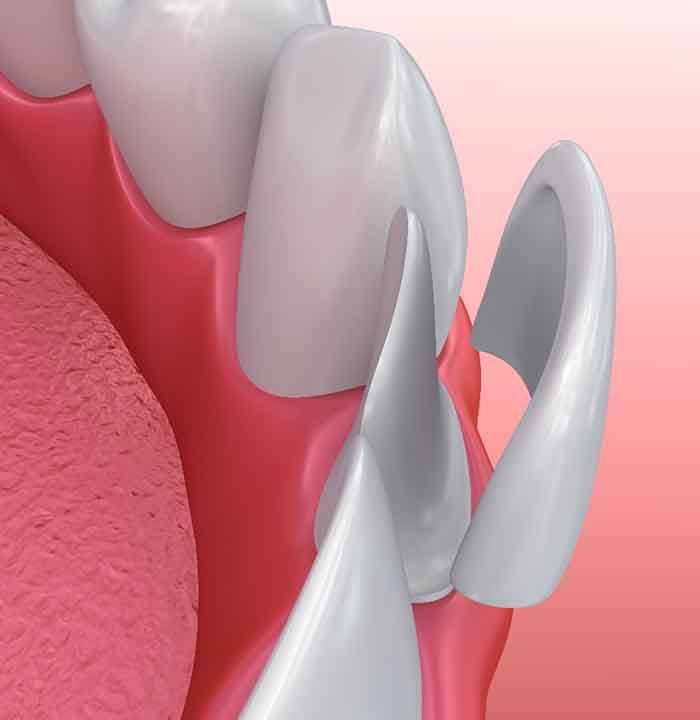Veneers & Lumineers
Shells That Lead to Stunning Smiles
Even if you want to fix your flawed teeth, you may think doing so is too much effort. Wouldn’t the process require a bunch of different dental services? However, the reality is that dentistry has a way to fix many smile flaws all at once: veneers and Lumineers! By placing either type of these shells, our dentists would make your grin look brand new. Simply keep reading or book a visit to learn more about them.

What are Dental Veneers & Lumineers?

In essence, veneers are tooth-sized shells placed over the fronts of teeth. They’re made to hide nearly any smile flaw – stains, chips, cracks, misalignments, etc. – once set. From there, each shell blends with the rest of your smile due to its porcelain or ceramic material. That means the final veneers look natural and match your other teeth in size, shape, and color.
Lumineers are special veneers made of ultra-thin, laminate porcelain. Unlike normal ones, they can often be placed in much less time and with less advanced dental work. They’ve thus earned the nickname of “no prep” veneers.
The Process of Getting Veneers & Lumineers

A normal veneer treatment takes at least two appointments: the initial “prep” visit and the later final placement. In contrast, a Lumineer procedure consists of two very short and non-invasive visits.
The veneer process always starts with a consultation visit. If it goes well, we’ll prepare your teeth by shaving away some of their enamel. This process makes room for the final veneers so they won’t stand out. Once done, we’ll take an impression of your teeth and send it to a lab. This lab’s workers will craft your final veneers while you wear mock ones for a few weeks. When the “real” veneers are ready, you’ll return to our office for their placement.
True enough, the Lumineer process also requires two dental visits; it isn’t a “one-and-done” deal. However, the first appointment is much shorter since our dentists won’t “prep” your teeth. Our team will just take an impression or mold and send it to a lab. Two to four weeks later, we’ll quickly place your Lumineers on the second visit.
The Benefits of Veneers & Lumineers

If you get veneers or Lumineers, the shells will offer you many benefits. These include:
- A Gorgeous Grin – Veneers use high-quality porcelain or ceramic, so they match your surrounding teeth. Lumineers also blend with your smile, though they’re a bit more translucent.
- Versatility – Once placed, both veneers and Lumineers can fix many smile flaws. Notable examples are stains, chips, cracks, fractures, and misalignments.
- Stain-Resistance – Veneers are stain-resistant, so the shells don’t discolor much from meals. The same applies to Lumineers, but note that they’re less effective at hiding enamel stains.
- Long-Lasting Results – An average veneer can last roughly 15 years, while a Lumineer has an average lifespan of 10 years.
Understanding the Cost of Veneers & Lumineers

Due to their features, maybe you’re concerned that veneers and Lumineers are too pricey. You wouldn’t want to commit to something that exceeds your budget. That said, the cost of veneers and Lumineers varies from patient to patient; you should consult our dentists for a precise estimate. From there, we can find ways to make care more affordable. We’ll even walk you through your treatment’s pricing factors and our office’s payment options.
Veneers & Lumineers FAQs
Are Veneers (or Lumineers) Permanent?
Neither veneers nor Lumineers are permanent; dentists must replace each shell type. That said, their placement can leave lasting effects.
Don’t forget that dentists remove some enamel to place veneers. This material doesn’t grow back over time, so the bits shaved away are gone for good. That means teeth “prepped” for veneers will always need the shells (or crowns) going forward; otherwise, you’d risk tooth sensitivity.
Of course, Lumineers can be placed without removing any enamel. They’re thus a reversible option and won’t permanently alter your teeth.
Is There Anything I Can’t Eat with Veneers?
Whether you have temporary or porcelain veneers, you should avoid certain foods to protect your treatment results. Anything less could ruin your transformed smile.
For example, lay off darkly pigmented meals if you have temporary veneers. These shells stain more easily than the final ones, so a poor food or drink choice could discolor them. You’d then have to live with an ugly smile until your porcelain veneers are ready to go.
Similarly, those with porcelain veneers should avoid sticky, hard, and crunchy foods. Sticky stuff could cling to your shells and eventually pull them off your teeth. On the other hand, tough or crunchy items could chip or crack your veneers; you’d then need replacements.
Do Veneers (or Lumineers) Change Your Face?
Actually, yes – veneers and Lumineers alike change your face. They make you look younger and more energized as a result.
The fact is that all veneers provide support to the mouth’s musculature. Because the mouth loses elasticity and muscle tone with time, said support makes a big difference. It often provides patients the same benefits as a facelift, all without surgery.
With all that said, you should consult your dentist about this matter. They’ll gladly explain the treatment’s impact on your face shape during your consultation.
Is It Painful to Get Veneers (or Lumineers)?
Fortunately, it doesn’t hurt to get veneers or Lumineers. Placing either kind of shell is a painless process that goes smoothly and easily.
For starters, a dentist will numb your mouth for veneer placement. This step ensures you won’t feel any pain from the procedure; the most you’ll sense is slight pressure. Even as a dental team “preps” your teeth, you shouldn’t experience any pain or soreness.
On the other hand, Lumineers don’t need prior numbing. Dentists don’t have to alter a patient’s teeth to place these thinner, “no-prep” veneers. As a result, they’re even less likely to cause any treatment-related pain.







